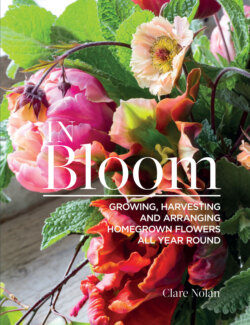Читать книгу In Bloom - Clare Nolan - Страница 9
На сайте Литреса книга снята с продажи.
ОглавлениеThink in terms of ingredients
When I first started growing flowers for cutting, it was passion led; I planted what I loved without any real planning. It worked to a degree. I had lots of beautiful blooms – roses that smelled divine, glorious armloads of tulips, and fistfuls of sweet peas – but I struggled to put together bouquets and mixed arrangements as I didn’t have the quantities of foliage or fillers to mix with them. I now work backwards from the displays I want to create and think in terms of the ingredients I’ll need, with everything I plant playing an important role within my displays. When building a mixed arrangement, it’s important to think in terms of shape – not just the flower head itself but also the overall growth habit or form of that flower, where relevant. It’ll help you create a good balance of color, texture, and shape within a display.
THE ROLES THAT FLOWERS, FOLIAGE, AND FILLERS PLAY
THE HEROES
These are the stars or the showstoppers, the focal point of a mixed arrangement and the beauties that catch your eye first. They tend to be the largest, showiest flowers in the display – normally these are large, round-headed flowers such as roses, peonies, and tulips.
THE SUPPORTING ACTS
Being secondary to the stars, these flowers are still beautiful in their own right, but they compliment rather than overtake the heroes – they can contrast or harmonize with the stars. The flowers you use will depend on which hero flowers you select – they should be smaller, but still catch your eye. You can introduce more than one secondary flower. It’s a good idea to mix up shapes, maybe using a spike or spire, such as on a snapdragon or larkspur, to add height, as well as a smaller, round-headed flower, such as on a small zinnia or cosmos, to help fill in any gaps.
THE FILLERS
Background flowers – the extras – along with foliage provide the bulk of an arrangement and are a chance to add texture and a little airiness. They bridge the gap between the hero flowers and supporting acts. Love-in-a-mist, lady’s mantle, and white lace flower are all fillers.
THE FOLIAGE
Foliage acts as a foil to the flowers. Think in terms of layers of foliage: sturdier stems bring structure and height to a display, while fillers or soft foliage bridge the gap between flowers, pad out, and add texture. There’s always room for special foliage – a trail or an arching stem that adds a little whimsy.
THE SIDEKICKS
These provide a little bit of quirk, an element that will be unique to you: a twisted stem, a trail of a flowering vine, or an unusual bloom in an unexpected color. These unexpected additions add the magic and personality to the vase arrangement.
Ingredients laid out ready for arranging: peonies as the hero flower, plumes of masterwort to act as a secondary flower and to add height; love-in-a-mist as filler; cotoneaster tree as structural foliage, and mint as the soft foliage, with curvy stems of bishop’s flower and a trail of love-in-a-puff to add a little quirk and whimsy.
The finished display.
PLANNING FOR A GOOD HARVEST
Once you’ve worked out your ingredients, it’s also essential to think in terms of each season to ensure you have sufficient material to pick throughout your growing year. I see it almost like a recipe; I start with my hero flowers and note when they are going to be in flower, then add the other ingredients I know will work well with them. For example, I sow a batch of hardy annuals such as bishop’s flower, honeywort, and love-in-a-mist in autumn so that they will be in flower to mix with the last of the spring bulbs such as late tulips and narcissi. At the same time, I’ll be able to pick granny’s bonnet and some early mint.
An autumnal color palette spotted during a visit to one of the nursery exhibits at Hampton Court Flower Show.
A bucket of spring flowers – fritillaries, narcissi, tulips, white borage, and granny’s bonnet.
